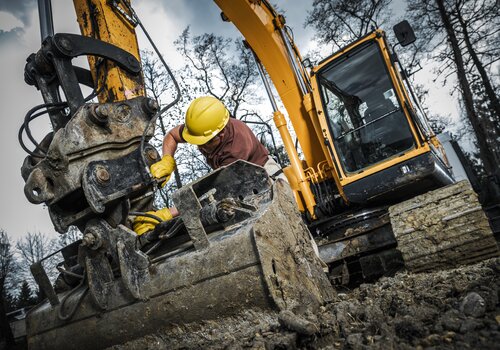Every November, the U.S. observes Critical Infrastructure Security and Resilience Month to raise awareness of the essential systems and assets that form the backbone of modern society. From transportation and energy to water systems and telecommunications, critical infrastructure keeps our communities functional and safe. For construction workers and heavy equipment operators, understanding the importance of critical infrastructure security is crucial. This month is dedicated to highlighting how construction professionals can contribute to protecting and maintaining these vital assets.
WHAT IS CRITICAL INFRASTRUCTURE?
Critical infrastructure refers to the physical and digital assets, networks and systems that are essential for the functioning of society. The U.S. Department of Homeland Security (DHS) has identified 16 critical infrastructure sectors, which include sectors like energy, water, transportation, healthcare and communications. These sectors are fundamental to public health, safety and economic stability. For example, a robust transportation infrastructure enables safe travel and timely delivery of goods, while the energy sector ensures that buildings and machinery operate smoothly on job sites.
For construction workers, these sectors translate into tangible assets and projects—bridges, roads, electrical grids and pipelines—that they build, maintain and repair. Any disruption to critical infrastructure can have serious repercussions, which is why resilience and security are essential.
WHY CONSTRUCTION WORKERS PLAY A KEY ROLE IN INFRASTRUCTURE SECURITY
Construction workers, by virtue of their hands-on role, are the first line of defense when it comes to securing and sustaining infrastructure. Here are some ways construction professionals contribute:
- Site Security: Construction sites often have high-value equipment and materials, which, if left unguarded, can become targets for theft, vandalism or even sabotage. Simple practices like maintaining secure perimeters, implementing entry/exit controls and regularly monitoring site activity can reduce vulnerability.
- Cyber Awareness: With increasing reliance on connected machinery and digital planning tools, cyber threats are becoming more relevant to construction work. Understanding basic cybersecurity practices—like using secure networks, regularly updating software and reporting suspicious emails or system activity—can help mitigate risks, particularly when dealing with smart construction technology or critical infrastructure projects.
- Training for Emergencies: Construction workers are trained to handle emergencies like fires, gas leaks or hazardous material spills, which are particularly relevant on sites tied to critical infrastructure. This readiness is vital because workers are often among the first to respond if something goes wrong and their training can help mitigate potential damage.
KEY AREAS OF FOCUS DURING CRITICAL INFRASTRUCTURE SECURITY & RESILIENCE MONTH
- Physical Security Measures
On-site security is a top priority, particularly for projects involving sensitive infrastructure like water treatment facilities, electrical grids or transportation hubs. Construction workers can help by reporting any suspicious activity and ensuring that only authorized personnel have access to the job site. Using robust locks, surveillance cameras and lighting are basic but effective measures to deter unauthorized access. - Resilience in Design and Construction
The resilience of infrastructure relies on building to withstand natural and human-made threats. Construction teams are increasingly using materials and methods that can handle extreme weather events, such as high winds, flooding and fires, which are becoming more frequent. Examples include using reinforced concrete, impact-resistant glass and flood barriers in vulnerable areas.
Resilient construction practices are essential for assets like bridges and levees, which face both environmental challenges and high traffic volumes. Workers play a vital role by implementing these resilient designs according to specifications and following strict safety and quality control measures during construction. - Safeguarding Digital Infrastructure
Digital systems, like automated controls for energy grids or water treatment facilities, are now integral to critical infrastructure. However, these systems also create vulnerabilities, as cyber-attacks on connected infrastructure are on the rise. Construction teams that work on projects involving connected infrastructure or smart technology should be aware of cybersecurity best practices, like securing devices, using strong passwords and only connecting to trusted networks. - Strengthening Collaboration
Critical Infrastructure Security & Resilience Month emphasizes collaboration among government, industry and local communities. Construction professionals are encouraged to collaborate with public agencies, site managers and engineers to ensure that projects meet security standards. Coordinated efforts between construction teams and local law enforcement or utility providers can also improve emergency response capabilities. - Emergency Preparedness and Response
Many critical infrastructure projects are in areas prone to natural disasters, such as coastal areas or regions with seismic activity. Construction workers should be aware of emergency procedures specific to each project site, like evacuation routes, emergency shutdown procedures for equipment and the location of fire extinguishers and first aid stations. Regular safety drills and emergency preparedness training are essential parts of creating a resilient work environment.
HOW CONSTRUCTION WORKERS CAN PARTICIPATE IN CRITICAL INFRASTRUCTURE SECURITY & RESILIENCE MONTH
Here are some ways construction professionals can actively contribute to Critical Infrastructure Security & Resilience Month:
- Attend Training Sessions: Many employers and industry groups offer training sessions and workshops during November focused on site security, cybersecurity and emergency preparedness. Attending these events can enhance your skills and understanding of critical infrastructure security.
- Stay Informed on Security Trends: Technological advancements in construction, like connected autonomous equipment, also introduce new security challenges. Staying informed on these trends will help construction workers prepare for potential security risks that accompany new technology.
- Promote a Security Culture: Security is a team effort, and creating a culture of security on construction sites is critical. Encourage team members to follow security protocols, report potential risks and support one another in creating a safe work environment.
- Participate in Community Awareness Events: Many local governments and organizations hold community events during Critical Infrastructure Security & Resilience Month to raise awareness about the importance of infrastructure security. Attending these events can provide insights into how local infrastructure contributes to the broader community and the role of construction workers in maintaining it.
BUILDING A SECURE FUTURE
For construction workers, Critical Infrastructure Security & Resilience Month serves as a reminder of the essential role they play in protecting and sustaining vital systems. Every bridge, road and power plant built strengthens the community, providing a foundation that supports public safety, economic growth and environmental resilience. By enhancing security practices, following resilient construction methods and staying aware of emerging security trends, construction professionals help safeguard not only the infrastructure they build but also the communities they serve.
Taking small steps to improve security can have a big impact, ensuring that critical infrastructure remains safe, resilient and reliable for generations to come.
Photo credit: ISTOCKPHOTO.COM/LEVKR












